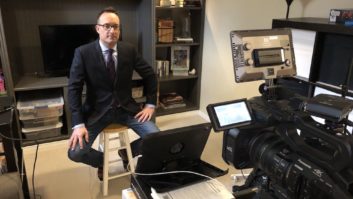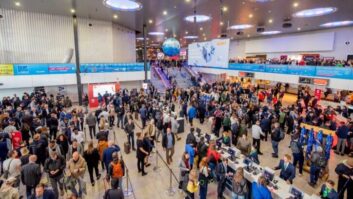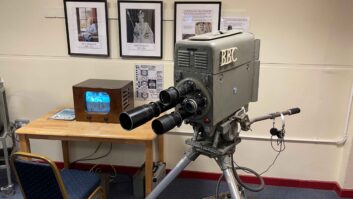Outcomes are stronger when we work together; we’ve always known this at Calrec, but don’t just take our word for it. In 2024, The Harvard Business Review published an article titled, “Why Collaboration Is Critical in Uncertain Times” which argues that during challenging times “the untapped potential of collaboration can be a game-changer.”

We agree. Collaboration not only speeds up the development of new technology but ensures it fit for purpose. The good news is over the last ten years, more companies have come into the broadcast industry to collaborate with.
And it’s all thanks to IP.
For a long time, broadcast manufacturers operated in silos; video was video, audio was audio, and that’s how it was. But in uncertain times when flexibility is the key to future growth, those silos are being broken down, and it’s the adoption of IP that has given broadcasters the opportunity to shape their workflows to suit their exact needs. The glue that holds all this together is the SMPTE ST 2110 suite of standards, and it’s well bedded in. Published in 2017, one year after AMWA’s NMOS IS-04 for device discovery and registration, and one year before IS-05 for connection management, these specifications have been adopted across the entire broadcast industry and guarantee interoperability between equipment of all flavours.
It is these standards that gave manufacturers the confidence to invest significant R&D dollars in implementing IP technology and it is these standards that have given broadcasters the confidence to make the transition from decades of embedded audio workflows and embrace more flexible, IP working practices.
We’re better together
For companies like Calrec, playing nicely with other manufacturers in an ST 2110 environment unlocks the door to a raft of next-generation workflows that can incorporate best-of-breed technologies from multiple manufacturers.
This gives everyone the flexibility to develop workflows in increasingly creative ways, while knowing that everything will work seamlessly together also means stronger working relationships can develop with trusted technology partners. And because it’s those vendors who are in the best position to adapt, improve and develop their specialist technologies, it ultimately delivers more choice and more control over how we work and the agility to adapt how we control everything.
The freedom to choose
Distributed production has transformed how broadcasters cover live events, driving down costs as well as carbon footprint by reducing travel for equipment and personnel. It also gives broadcasters the flexibility to meet the specific needs of individual productions, using either localised edge processing or creating a presentation mix from an acoustically treated centralised studio.
More recently, the growing acceptance of resources in the cloud has also encouraged broadcasters to spin-up cost-efficient cloud processing for one-off productions, with no extra CapEx investment in additional hardware. The ability to spin-up additional cost-efficient resources in a cloud-native environment like Calrec’s ImPulseV delivers even more flexibility, especially for ad hoc one-off productions that need more processing power. It has led to an increase in more ambitious large-scale orchestration systems and virtualising of productions, and distributed DSP that enables large mixers with thousands of channels of audio to be replaced by lots of DSP in lots of different places. This gives more control to broadcasters allowing a single surface to control multiple DSP engines located anywhere, providing versatility and virtualisation.
The expansion of these production ecosystems is where the real value is for broadcasters. Calrec’s True Control 2.0 exploits this trend, giving the ability to control any Calrec system from anywhere in the world. It provides access to more cores and more surfaces, wherever they are. In fact, each controller console can access up to five other consoles simultaneously to give broadcasters much greater levels of remote control without the limitations of mirroring or parallel controlling. In addition to ImPulseV, True Control 2.0 works with Argo M, Argo Q, Argo S and Type R, allowing any of these products to remotely control any other True Control 2.0 enabled product.
Expanding the ecosystem
Having the freedom to independently plan and control your workflows cannot be underestimated, and the ability to pivot to take advantage of technological changes is essential to survival. Whether it’s audio, video, graphics, comms, or any other broadcast specialism, the relationships we have with our chosen technology partners and suppliers help deliver those levels of autonomy on both sides of production.
In live broadcast, where reliability is paramount and technologies have to be trusted, knowing you have experts on your team is important because you can be sure that specialist manufacturing R&D departments are always going to be several steps ahead, developing products that deliver what the industry is going to need in the future as well as what it’s using today.
However you look at it, these relationships make everyone more agile, and in today’s distributed marketplace, that’s a huge benefit.







